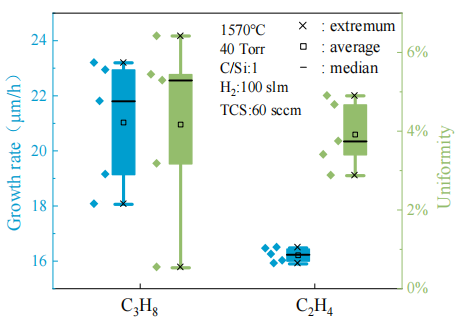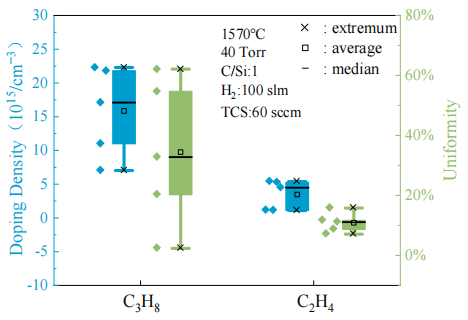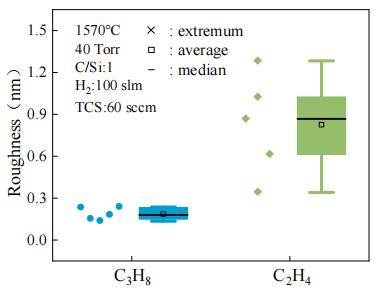Abstract: In this study, a 4H-SiC homoepitaxial layer was grown on a 150 mm 4◦ off-axis substrate using a horizontal hot wall chemical vapor deposition reactor. Comparing C3H8 and C2H4 as C sources, the sample grown with C2H4 exhibited a slower growth rate and lower doping concentration, but superior uniformity and surface roughness compared to the C3H8 -grown sample. Hence, C2H4 is deemed more suitable for commercial epitaxial wafer growth. Increasing growth pressure led to decreased growth rate, worsened thickness uniformity, reduced doping concentration, deteriorated uniformity, and initially improved and then worsened surface roughness. Optimal growth quality was observed at a lower growth pressure of 40 Torr. Furthermore, the impact of buffer layer growth on epitaxial quality varied significantly based on different C/Si ratios, emphasizing the importance of selecting the appropriate conditions for subsequent device manufacturing.
1. Introduction
The limitations of traditional Si-based power devices in advanced applications are becoming apparent due to low conduction voltage drops and limited high-frequency switching capabilities, becoming significant factors hindering the progress of modern electronic equipment. On the other hand, SiC devices offer a new solution due to their durable nature and exceptional performance in extreme conditions . This durability is not only evident in their ability to withstand high temperatures and electrical loads but also in their stability in high-radiation environments, a feat that Si devices struggle to match. The low power consumption of SiC devices is particularly crucial in today’s electronic devices, given the increasing demand for power efficiency and heat dissipation . This characteristic allows SiC devices to generate less heat under the same operating conditions, thereby alleviating the strain on heat dissipation systems. Consequently, this not only facilitates equipment miniaturization but also reduces operating and maintenance costs, while enhancing equipment reliability and longevity by lowering cooling system requirements. As manufacturing technology advances and economies of scale are realized, the cost of SiC devices gradually decreases, leading to expanded applications across various industries. In the long term, SiC technology is poised to revolutionize key fields such as energy efficiency, power electronics, transportation, and industrial automation, offering more efficient and reliable technical solutions and driving industries toward a more sustainable and environmentally friendly future.
The production of SiC epitaxial wafers is crucial for manufacturing SiC devices. As the complexity and diversity of the working environment continue to increase, the quality standards for SiC devices become more stringent. SiC devices must exhibit increased reliability, stability, and durability to withstand various extreme conditions and highintensity workloads. The key to achieving these objectives lies in enhancing the quality of the SiC epitaxial layer, as its quality significantly impacts the overall performance and longevity of the device . Consequently, elevated demands have been placed on improving and controlling the growth rate, doping concentration, and surface quality of the epitaxial layer. Chemical vapor deposition (CVD) is a widely used technique for depositing thin films on a substrate through chemical reactions of vapor precursors at high temperatures. By adjusting process parameters, the film’s structure can be modified. In comparison to other growth methods, CVD offers precise control over the thickness, impurity doping, and uniformity of the epitaxial layer. As a result, the 4H-SiC homoepitaxial layer produced using this method exhibits superior quality and can be directly utilized in the fabrication of SiC devices.
2.Results and Discussion
Figure 1 illustrates that utilizing CaHs as the carbon source for growth results in asignificantly higher growth rate compared to using CzH. This indicates the superiorefficiency of CaHs in promoting faster epitaxial layer growth under similar conditions.However, rapid growth does not guarantee uniform growth quality. Further analysis of thegrowth rate distribution of individual samples revealed distinct differences. Samples grownwith CgHs exhibit a wide dispersion in growth rate, indicating significant fluctuationsamong samples. Conversely, samples grown with CHy show a more concentrated growthrate distribution with smaller fluctuations,suggesting greater stability. While the minimumsurface thickness uniformity value ofCaHs-grown samples may be low, indicating someuniformity in certain areas, the distribution range is wide, resulting in overall samplesurface thickness variation and suboptimal uniformity. On the other hand, althoughthe overall surface thickness uniformity value of CH4-grown samples is slightly higherimplying a slightly larger average thickness difference, the distribution is more compactwith a smaller variation range. This highlights that using C,H as the carbon sourcecan maintain a relatively consistent level of surface thickness quality across samplesdemonstrating better uniformity.

Figure 1. Epitaxial growth rate and thickness uniformity of C sources.
Figure 2 illustrates the distinct impact of various C sources on the doping concen.tration and uniformity of the epitaxial layer. The data clearly indicate that the dopingconcentration in the epitaxial layer produced using CzHy is generally lower compared tothat grown with CgHs, whether examining a single sample or the average across all samplesThis discrepancy can be attributed to the differing chemical properties of C,H.CHbeing more chemically active than CHs, readily decomposes at elevated temperaturesto create a C-rich environment [33]. During the growth process of 4H-SiC, N atoms andC atoms have the same lattice site occupancy, which leads to a competition effect betweenthem. In a Si-rich environment, N atoms can effectively replace the lattice positions olC atoms, thereby significantly improving the Nz doping efficiency. This environment aidsin minimizing impurity or dopant introduction during grwth, leading to reduced dopingconcentration. Consequently, C,Hdemonstrates superior efficacy in regulating dopingconcentration. In terms of uniformity, the epitaxial layer from the GH-grown sample alsodisplays commendable performance. Analysis of samples grown with different C sourcesreveals that the CzH4grown sample exhibits a more concentrated distribution of unifor mity values, indicating minor variations in doping concentrations across different regionsMoreover, the values are generally low, suggesting high overall doping concentrationuniformity. Conversely, the uniformity of the CaHs-grown sample appears slightly lessfavorable. Therefore,C,H as a C source not only excels in controlling doping concentra.tion in the epitaxial layer but also demonstrates exceptional uniformity in maintainingdoping concentration.

Figure 2. Doping concentration and uniformity of C source epitaxial layers.
However, when turning to observations of the surface morphology of 4H-SiC, thesituation changes. Surface topography is an important factor in evaluating material qualityand device performance, especially in the post-production stage of devices, such as theformation of ohmic contacts. Figure 3 illustrates the roughness comparison in epitaxialayers grown using different C sources.

Figure 3. The surface roughness of different C source epitaxial layers.
The data clearly indicate that epitaxial layers grown with C3H8 exhibit extremely low surface roughness, measuring less than 0.25 nm and showcasing a remarkably smooth surface. This low roughness surface is advantageous for facilitating good ohmic contact formation and enhancing device performance. Conversely, epitaxial layers grown with C2H4 display relatively high surface roughness, with significant variation among different samples. This elevated roughness could result in subpar ohmic contact effects and compromise overall device performance. The AFM images in Figure 4 further support these findings, showing more undulations and irregular structures on samples grown with C2H4 compared to the relatively flat surface of samples grown with C3H8. It is hypothesized that the difference in surface quality may be attributed to the differing chemical reactivity of C2H4 and C3H8. Specifically, the increased likelihood of decomposition and reaction of C2H4 during high-temperature growth could contribute to surface instability and unevenness. Due to its more stable chemical properties, C3H8 may be more conducive to forming a uniform and smooth surface during the growth process. Therefore, C3H8 may be a more suitable choice in device applications that pursue low surface roughness and good ohmic contact effects.

Fig4
4. Conclusions
This study delved into the impact of three crucial process parameters on the homoepitaxial growth of 4H-SiC on 4H-SiC substrates, focusing on epitaxial layer growth rate (thickness), doping concentration, uniformity, and surface roughness. The comparison between growth conditions using C3H8 and C2H4 as carbon sources revealed that while C3H8 led to a faster growth rate, it resulted in a more dispersed growth rate distribution among samples and poorer surface thickness uniformity. On the other hand, C2H4, despite yielding a slightly slower growth rate, provided a more stable growth process and significantly improved surface thickness uniformity. Furthermore, the C2H4-grown epitaxial layer exhibited lower doping concentration but better doping uniformity. Analysis of surface morphology indicated that the epitaxial layer grown with C3H8 had lower surface roughness, possibly due to specific characteristics of C3H8 during growth. Conversely, the epitaxial layer grown with C2H4 displayed higher surface roughness, potentially linked to the more active chemical properties of C2H4 at high temperatures, leading to a more complex growth process. Considering these factors, it can be inferred that C2H4 outperforms C3H8 in terms of growth stability, doping concentration control, and surface morphology, making it the preferred carbon source for 4H-SiC epitaxial growth.
下一篇: 微针设备:设计、制造和应用